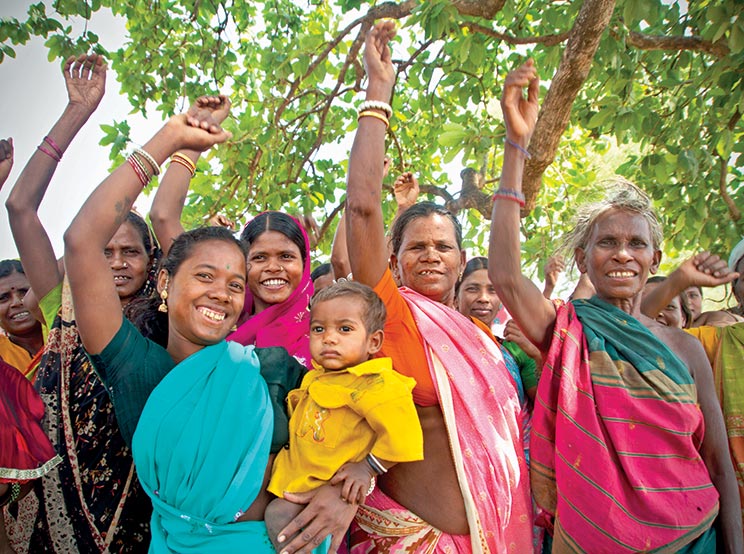Amitabh Behar
Biz@India
May 2018
Despite world leaders signing global agreements to reduce socio-economic inequality, gap between the rich and the rest has widened. As economic growth benefits only some percent of the social strata in India, Amitabh Behar, CEO, Oxfam India, talks about the vision of developing an economy for the 99 pc and elucidates factors of this paradox.
In an era of economic growth defined by inequality and exclusivity, women remain worse off. Most of the rural and even many urban women are unaware about their rights due to a lack of knowledge. Does Oxfam work on raising awareness on this issue?
Oxfam is devoted to putting women at the heart of our work. We believe that the potential for lasting change lies in the hands of millions of women currently living in poverty.
For around a decade, Oxfam India has been working with women in the most marginalised communities of the five poorest states of India to make them aware about their rights on the issues of domestic violence, child marriage, empowering them to challenge patriarchal social norms and ensure greater participation in gram sabhas. Despite their contribution to the Indian agricultural economy, women own just 13 pc of land in India and do two-thirds of all farm work. Women farmers in India have been demanding recognition of their land rights and Oxfam India has been campaiging and advocating for their economic empowerment.
Despite 50 pc of India’s population being women, their persistent under-representation in political life and decision-making has led to a ‘democratic deficit’ in the country. Oxfam India is part of the coalitions of civil society organisations, activists and political think tanks leading to get the 33 pc Women’s Reservation Bill passed. From access to quality healthcare and education, conservation of forest rights to natural disasters– gender justice is the front runner across all our projects.
What is the gender gap in the corporate world, within various sectors?
During the last 10 years, the labor force participation rate of Indian women, already very low compared to other Asian countries, has fallen from 37 to 27 pc. In the latest Global Gender Gap Index, India ranks 139 of 144 on the parameter of economic participation. New data has also revealed India’s gender gap in women’s share among legislators, senior officials and managers, as well as professional and technical workers for the first time in recent years. India needs to do more to achieve parity in economic opportunity and participation of women. As per a UN Women report on women’s economic empowerment more than 90 pc of women employed in India work in the informal sector.
This means that a huge proportion of working women do not even get access to basic entitlements for health and social well-being.
In the corporate sector, women still go largely under-represented on boards. Many listed companies seem to find it hard to hire even one competent woman for their board, a mandatory under the Companies Act.
In India, the richest 2-3 pc of people control 60 pc of the total wealth. What have been the reasons behind this growing inequality? Would you say successive governments have failed to address the concerns of the latter?
We cannot deny that in the last few decades inequality in India has increased. One of the reasons has been the nexus between the richest Indians and those in power—crony capitalism rather than innovation, hard-work or fair rules of market has aided the disproportionate increase in the wealth of the top one pc. From favorable allocation of natural resources to easy credit access from the financial sector, the richest in India get it all. In 2017, the wealth of this elite group increased by INR 20,913 billion. This amount is equivalent to the total budget of central government in 2017-18.
The recent scams like 2G scam, coal scam, Nirav Modi bank fraud are evidence of this crony capitalist system supporting the richest in making their wealth. Moreover, a look at the non-performing assets of the public sector banks clearly establishes that majority of these defaulting companies are held by the richest Indians.
The super-rich and the corporates have been robbing India of its wealth. The super-rich are paying as little tax as possible, using the secretive global network of tax havens, as revealed by the Panama Papers and other exposés.
Corporates in India are also supported by the government through hefty tax exemptions which adversely affects the government’s spending capacity on social security policies.
It is even more concerning as our country is already fractured along the lines of caste, religion, gender and other social inequalities. Our story of rising inequality is as much about rising income, wealth inequality as it is about inequality in non-income dimensions such as education, health, nutrition and opportunities.
Any level of inequality is the outcome of policy choices made by governments. Successive governments have failed in their responsibility to allocate resources for several progressive social policies and legislation like National Food Security Act, National Rural Employment Guarantee Program, Right to Education, Forest Rights Act. Governments have failed to create a system where all people have access to basic services such as quality healthcare and education, and where the rich pay their fair share of taxes.
In the context of demonetisation, has the problem of inequality aggravated?
Available data on demonetisation clearly shows that it has adversely impacted the populace dependent on the informal sector for their livelihood and if this remains unchecked, then, it can result in aggravating inequality, especially in rural areas. Around 93 pc of India’s workforce is reliant on the cash dependent informal sector.There is evidence that cash crunch has forced the rural populace to liquidate their assets to find an alternate to financial transactions.
What policy actions do you think are required to address this growing inequality?
The socio-economic legal setup should provide proportionate space for the concerns of women, minority and socially marginalised groups. The policy framework of the government should focus on investing in human development, ensuring inequalities of outcomes on education and health decline, empowering people and ensuring their basic rights and entitlements.
India needs to promote inclusive growth by ensuring that the income of the bottom 40 pc of the population grows faster than of the top 10 pc, so that the gap between the two begins to close. While it sounds ambitious, it is possible to this by promoting labour-intensive sectors that will create more jobs; investing more in agriculture, health and education; withdrawing corporate tax exemptions; introducing inheritance tax on the super-rich; and implementing fully the social protection schemes that exist.
Countries such as Chile and South Africa have raised taxes on corporations and wealthy individuals generating millions of dollars to invest in vital public services.
India needs to take the challenge of inequality head on. It must be government’s priority to produce and make available high quality data on income and wealth. In addition to funding more household surveys, other data sources should be published to shed light on income and wealth concentration at the top one per cent. Lack of data and poorquality data pose a major challenge to quantify the extent of inequality within the country. There is an urgent need to develop serious political will on the issue or else we are looking at a fragile future– societal breakdown and peace under threat.
What have been the trends and patterns of inequality in various dimensions in India?
What puts India amongst countries with highest inequalities? Inequality in India is multi dimensional: There are inequalities in wealth, income and consumption, as well as structural inequalities of opportunity, region and social groups.
Over the years, government policies favored capital over labour and within labour there was a higher demand for skilled labour as opposed unskilled. The impact of this was seen on the sectors like agriculture which employed a large section of unskilled workforce . The path of inequality has changed in India—from being stagnant in the 1980s, to its increase since 1991, and to its subsequent and continued surge in recent years until 2017. These inequalities are the result of package of reforms adopted during the big bang liberalisation of 1991 and the subsequent policies adopted.
India is not doing enough to act on its commitment to fulfill the UN SDG Goals of reducing inequality. Oxfam and Development Finance International through a global index ranked 152 governments across the world on their commitment to reducing inequality (CRI). Sadly, India ranks a low 132 out of 152 countries. In other words, it is a country with high inequality combined with a low commitment to doing anything about it. On social spending, which includes health, education and social protection, India has a dismal ranking of 149. Several African countries like Mozambique, Central African Republic, Burkina Faso, Malawi, Zambia continue to spend more and achieve a higher ranking despite being poorer than India.
Are there enough opportunities and infrastructure in the country for differently-abled, lower castes and communities like the LGBT?
It is an empathic number. The sad truth is India lacks a strong mechanism to recognise the differently-abled and LGBT. The data itself is extremely suspect and insufficient. In the recent past some attempts have been made to confer more rights, the passage of The Rights of Persons with Disabilities Bill 2016 is one among them. However, implementation and monitoring remains poor. Criminalisation of homosexuality violates the rights of LGBT community to equality, dignity, expression and privacy. By penalising the community, we fail to recognize them.
Affirmative action has largely been central part of India’s policy framework however there have been major gaps in its realisation. Dalits continue to bear the burden of our outcome failures and face exclusion in the society. Our policy decisions, its implementation and public discourse fails to adequately understand these social classes. Dalits, differently abled, LGBT and other marginalised communities continue to live with indignity and discrimination.












